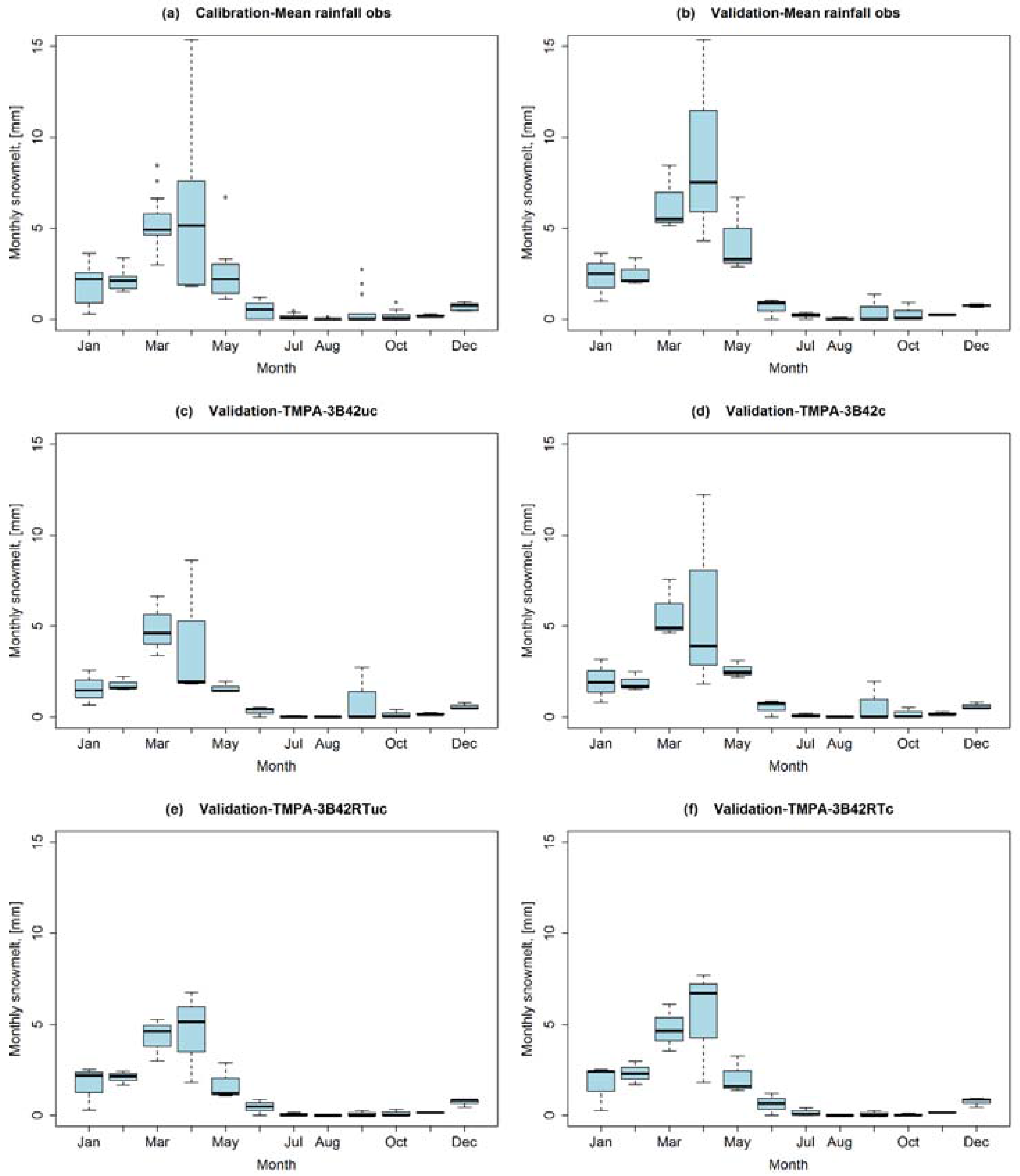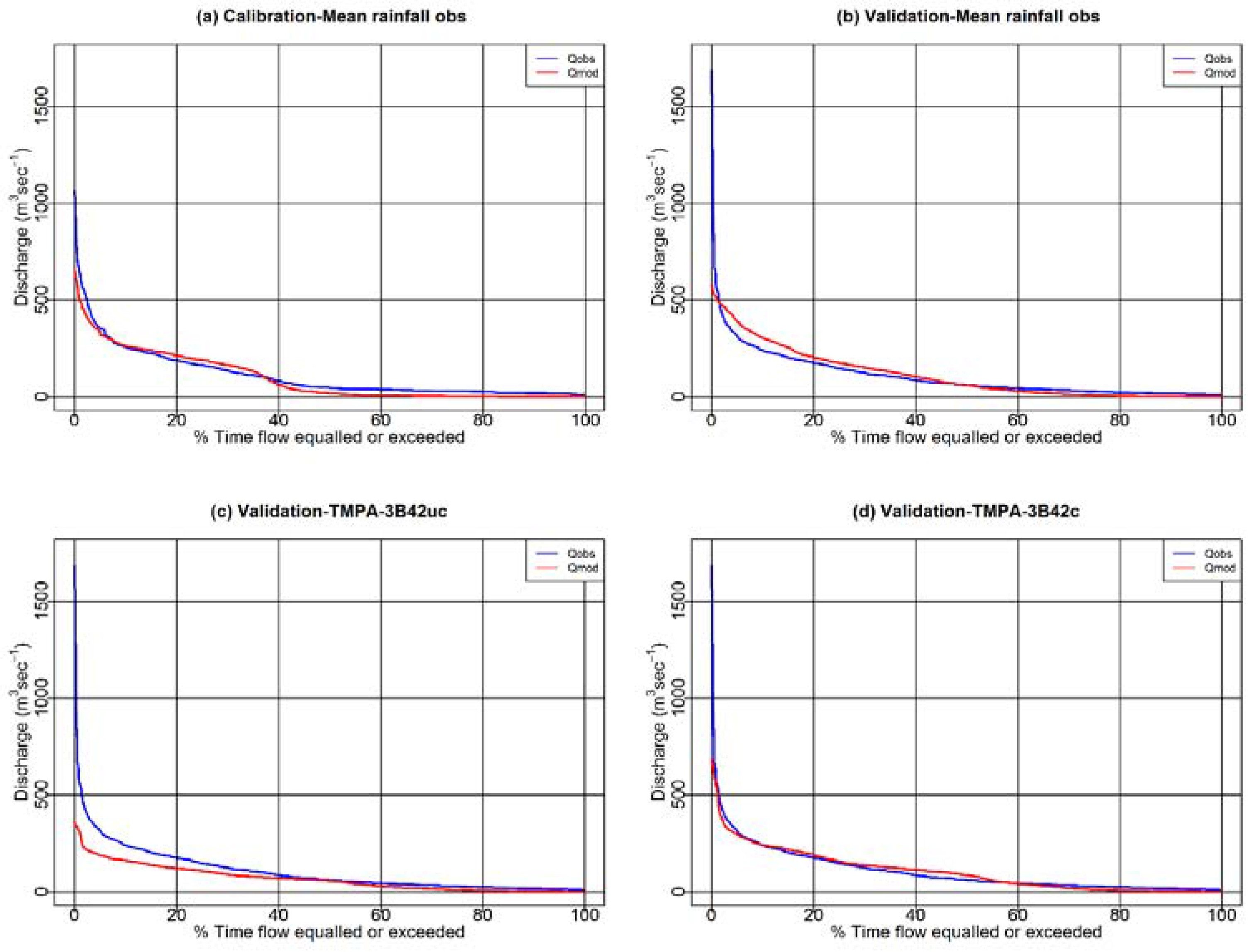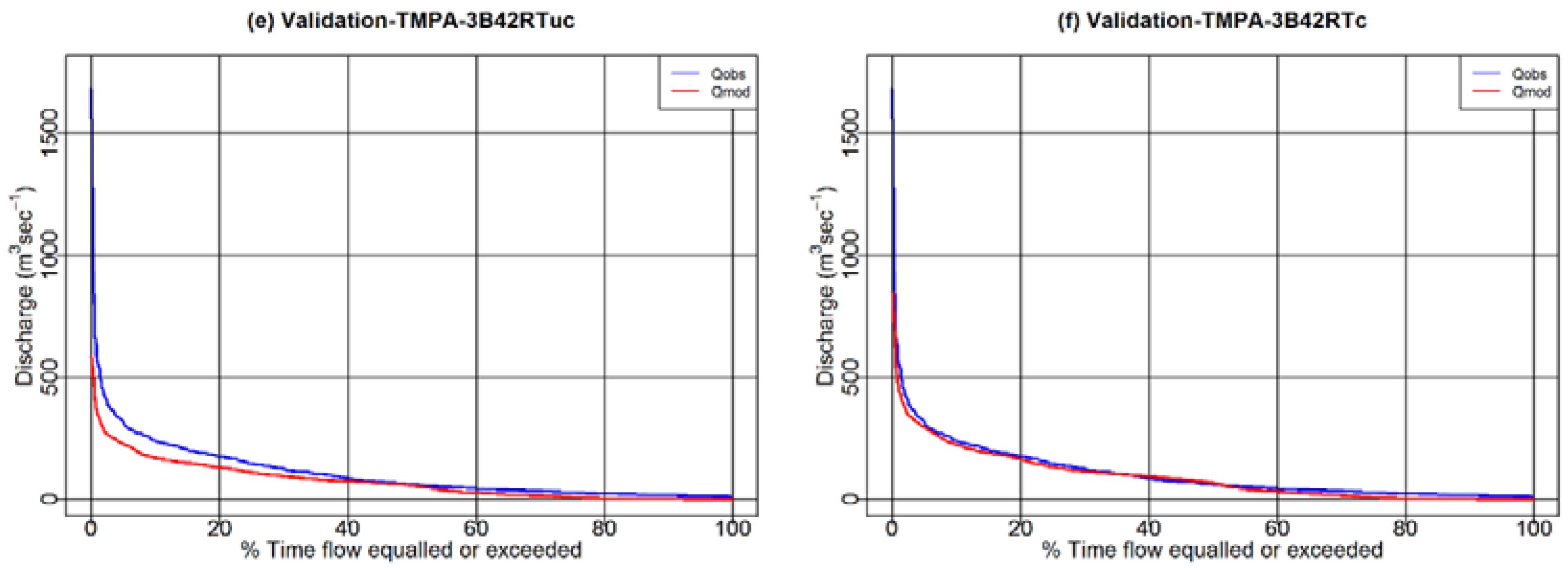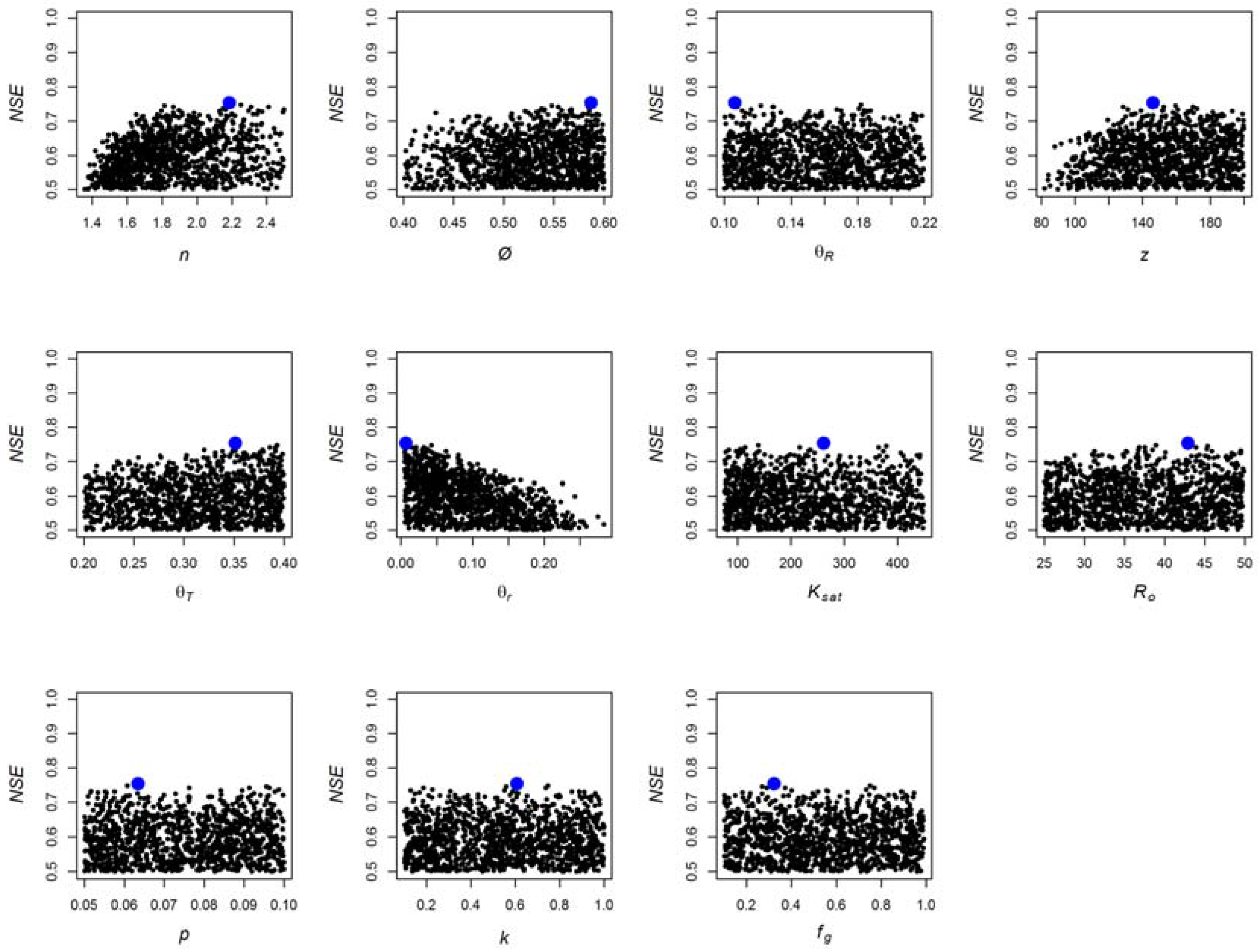Application of Satellite-Based Precipitation Estimates to Rainfall-Runoff Modelling in a Data-Scarce Semi-Arid Catchment
Abstract
:1. Introduction
2. Materials and Methods
2.1. Study Area
2.2. Data Acquisition
2.3. TRMM Data
2.4. TRMM Correction
2.5. Rainfall-Runoff Model
2.6. Calibration and Validation of the LEMSAR Model
2.7. Equifinality and Sensitivity Analysis in LEMSAR
3. Results
3.1. Comparison Between Gauged Rainfall and TRMM Data
3.2. Comparing Observed and Simulated Discharge
3.3. Contribution of Snowmelt and Groundwater Flow to Simulated River Discharge
3.4. Flow Duration Curves
3.5. Equifinality
4. Discussion
5. Conclusions
Supplementary Materials
Acknowledgments
Author Contributions
Conflicts of Interest
References
- Wheater, H.S. Progress in and prospects for fluvial flood modelling. Philos. Trans. Ser. A Math. Phys. Eng. Sci. 2002, 360, 1409–1431. [Google Scholar] [CrossRef] [PubMed]
- Beaumont, P.; Blake, G.; Wagstaff, J.M. The middle East: A Geographical Study, 2nd ed.; Routledge: Oxford, UK, 2016. [Google Scholar]
- Sawunyama, T.; Hughes, D.A. Application of satellite-derived rainfall estimates to extendwater resource simulation modelling in South Africa. Pretoria Water Res. Comm. 2008, 34, 1–9. [Google Scholar]
- Collischonn, B.; Collischonn, W.; Tucci, C.E.M. Daily hydrological modeling in the amazon basin using trmm rainfall estimates. J. Hydrol. 2008, 360, 207–216. [Google Scholar] [CrossRef]
- Draper, C.S.; Walker, J.P.; Steinle, P.J.; de Jeu, R.A.M.; Holmes, T.R.H. An evaluation of AMSR–E derived soil moisture over Australia. Remote Sens. Environ. 2009, 113, 703–710. [Google Scholar] [CrossRef]
- Voss, K.A.; Famiglietti, J.S.; Lo, M.; Linage, C.; Rodell, M.; Swenson, S.C. Groundwater depletion in the middle east from grace with implications for transboundary water management in the tigris-euphrates-western iran region. Water Resour. Res. 2013, 49, 904–914. [Google Scholar] [CrossRef] [PubMed]
- Beven, K.J.; Alcock, R.E. Modelling everything everywhere: A new approach to decision-making for water management under uncertainty. Freshwater Biol. 2012, 57, 124–132. [Google Scholar] [CrossRef]
- Huffman, G.J.; Adler, R.F.; Morrissey, M.M.; Bolvin, D.T.; Curtis, S.; Joyce, R.; Mcgavock, B.; Susskind, J. Global precipitation at one-degree daily resolution from multisatellite observations. J. Hydrometeorol. 2001, 2, 36–50. [Google Scholar] [CrossRef]
- Center, E.O. Trmm Data Users Handbook; National Space Development Agency of Japan: Hiki-gun, Saitama, Japan, 2001. [Google Scholar]
- Huffman, G.J.; Bolvin, D.T.; Nelkin, E.J.; Wolff, D.B.; Adler, R.F.; Gu, G.; Hong, Y.; Bowman, K.P.; Stocker, E.F. The trmm multisatellite precipitation analysis (TMPA): Quasi-Global, multiyear, combined-sensor precipitation estimates at fine scales. J. Hydrometeorol. 2007, 8, 38–55. [Google Scholar] [CrossRef]
- McCollum, J.R.; Gruber, A.; Ba, M.B. Discrepancy between gauges and satellite estimates of rainfall in equatorial africa. J. Appl. Meteorol. 2000, 39, 666–679. [Google Scholar] [CrossRef]
- New, M.; Lister, D.; Hulme, M.; Makin, I. A highresolution data set of surface climate over global land areas. Clim. Res. 2002, 21, 1–25. [Google Scholar] [CrossRef]
- Zulkafli, Z.; Buytaert, W.; Onof, C.; Manz, B.; Tarnavsky, E.; Lavado, W.; Guyot, J.-L. A comparative performance analysis of TRMM 3B42 (TMPA) versions 6 and 7 for hydrological applications over Andean–Amazon river basins. J. Hydrometeorol. 2014, 15, 581–592. [Google Scholar] [CrossRef]
- Nerini, D.; Zulkafli, Z.; Wang, L.-P.; Onof, C.; Buytaert, W.; Lavado-Casimiro, W.; Guyot, J.-L. A comparative analysis of TRMM–rain gauge data merging techniques at the daily time scale for distributed rainfall–runoff modeling applications. J. Hydrometeorol. 2015, 16, 2153–2168. [Google Scholar] [CrossRef]
- Zubieta, R.; Getirana, A.; Espinoza, J.C.; Lavado, W. Impacts of satellite-based precipitation datasets on rainfall–runoff modeling of the Western Amazon basin of Peru and Ecuador. J. Hydrol. 2015, 528, 599–612. [Google Scholar] [CrossRef]
- Zubieta, R.; Saavedra, M.; Silva, Y.; Giráldez, L. Spatial analysis and temporal trends of daily precipitation concentration in the Mantaro River basin: Central andes of Peru. Stoch. Environ. Res. Risk Assess. 2016, 1–14. [Google Scholar] [CrossRef]
- Harris, A.; Rahman, S.; Hossain, F.; Yarborough, L.; Bagtzoglou, A.C.; Easson, G. Satellite-based flood modeling using TRMM-based rainfall products. Sensors 2007, 7, 3416–3427. [Google Scholar] [CrossRef]
- Beven, K.J.; Kirkby, M.J. A physically based, variable contributing area model of basin hydrology/Un modèle à base physique de zone d’appel variable de l’hydrologie du bassin versant. Hydrol. Sci. Bull. 1979, 24, 43–69. [Google Scholar] [CrossRef]
- Tarnavsky, E.; Mulligan, M.; Ouessar, M.; Faye, A.; Black, E. Dynamic hydrological modeling in drylands with trmm based rainfall. Remote Sens. 2013, 5, 6691–6716. [Google Scholar] [CrossRef]
- Buringh, P. Soils and Soil Conditions of Iraq; Agricultural Research and Projects; Ministry of Agriculture: Baghdad, Iraq, 1960. [Google Scholar]
- Krásný, J.; Alsam, S.; Jassim, S.Z. Hydrogeology. In Geology of Iraq, 1st ed.; Publishers Dolin: Prague, Czech Republic, 2006; pp. 251–287. [Google Scholar]
- Qader, S.H.; Dash, J.; Atkinson, P.M.; Galiano, V.R. Classification of vegetation type in Iraq using satellite-based phenological parameters. IEEE J. Sel. Top. Appl. Earth Obs. Remote Sens. 2016, 43, 1–23. [Google Scholar] [CrossRef]
- Rasul, A.; Balzter, H.; Smith, C. Diurnal and seasonal variation of surface urban cool and heat islands in the semi-arid city of Erbil, Iraq. Climate 2016, 4, 42. [Google Scholar] [CrossRef]
- Food and Agriculture Organization (FAO). Country Pasture/Forage Resource Profiles. Rome, Italy, 2011. Available online: http://www.fao.org/ag/agp/AGPC/doc/Counprof/Iraq/Iraq.html (accessed on 9 January 2016).
- Zaitchik, B.F.; Evans, J.P.; Smith, R.B. Regional impact of an elevated heat source: The zagros plateau of iran. J. Clim. 2007, 20, 4133–4146. [Google Scholar] [CrossRef]
- R Development Core Team. R: A Language and Environment for Statistical Computing; R Foundation for Statistical Computing: Vienna, Austria, 2014; Available online: http://www.R-project.org/ (accessed on 5 January 2016).
- Arias-Hidalgo, M.; Bhattacharya, B.; Mynett, A.E.; van Griensven, A. Experiences in using the TMPA-3B42R satellite data to complement rain gauge measurements in the ecuadorian coastal foothills. Hydrol. Earth Syst. Sci. 2013, 17, 2905–2915. [Google Scholar] [CrossRef]
- Seo, D.J.; Breidenbach, J.P.; Johnson, E.R. Real-time estimation of mean field bias in radar rainfall data. J. Hydrol. 1999, 223, 131–147. [Google Scholar] [CrossRef]
- Immerzeel, W.W.; Rutten, M.M.; Droogers, P. Spatial downscaling of TRMM precipitation using vegetative response on the Iberian Peninsula. Remote Sens. Environ. 2009, 113, 362–370. [Google Scholar] [CrossRef]
- Cheema, M.J.M.; Bastiaanssen, W.G.M. Local calibration of remotely sensed rainfall from the trmm satellite for different periods and spatial scales in the Indus Basin. Int. J. Remote Sens. 2012, 33, 2603–2627. [Google Scholar] [CrossRef]
- Bouwer, L.M.; Aerts, J.C.J.H.; van de Coterlet, G.M.; van Giesen, N.; Gieske, A.; Manaerts, C. Evaluating downscaling methods for preparing global circulation model (GCM) data for hydrological impact modelling. In Climate Change in Contrasting River Basins: Adaptation Strategies for Water, Food and Environment; Aerts, J.C.J.H., Droogers, P., Eds.; Cabi Press: Wallingford, UK, 2004; Chapter 2; pp. 25–47. [Google Scholar]
- Whelan, M.J.; Gandolfi, C. Modelling of spatial controls on denitrification at the landscape scale. Hydrol. Process. 2002, 16, 1437–1450. [Google Scholar] [CrossRef]
- Pullan, S.P.; Whelan, M.J.; Rettino, J.; Filby, K.; Eyre, S.; Holman, I.P. Development and application of a catchment scale pesticide fate and transport model for use in drinking water risk assessment. Sci. Total Environ. 2016, 563–564, 434–447. [Google Scholar] [CrossRef] [PubMed]
- Hargreaves, G.H.; Samani, Z. Reference crop evapotranspiration from ambient air temperature. Am. Soc. Agric. Eng. 1985. [Google Scholar] [CrossRef]
- Hess, T.; Harrison, P.; Counsell, C. Wasim Technical Manual; HR Wallingford: Wallingford, UK; Cranfield University: Cranfield, UK, 2000. [Google Scholar]
- Kirkby, M.J.; Irvine, B.J.; Jones, R.J.A.; Govers, G. The pesera coarse scale erosion model for Europe. I.—Model rationale and implementation. Eur. J. Soil Sci. 2008, 59, 1293–1306. [Google Scholar] [CrossRef]
- van Genuchten, M.T. A closed-form equation for predicting the hydraulic conductivity of unsaturated soils. Soil Sci. Soc. Am. J. 1980, 44, 892–898. [Google Scholar] [CrossRef]
- Miller, W.F. Density Altitude Maps of Iran and Iraq (No. Usafetac/pr—91/008); Air Force Environmental Technical Applications Center: St. Clair County, IL, USA, 1991. [Google Scholar]
- Bergström, S.; Singh, V. The HBV model. In Computer Models of Watershed Hydrology; Water Resources Publications: Colorado, CO, USA, 1995; pp. 443–476. [Google Scholar]
- Fontaine, T.; Cruickshank, T.; Arnold, J.; Hotchkiss, R. Development of a snowfall–snowmelt routine for mountainous terrain for the soil water assessment tool (SWAT). J. Hydrol. 2002, 262, 209–223. [Google Scholar] [CrossRef]
- Kustas, W.P.; Rango, A.; Uijlenhoet, R. A simple energy budget algorithm for the snowmelt runoff model. Water Resour. Res. 1994, 30, 1515–1527. [Google Scholar] [CrossRef]
- Pipes, A.; Quick, M. Modelling large scale effects of snow cover. In Large Scale Effects of Seasonal Snow Cover; International Association of Hydrological Sciences Press, Institute of Hydrology, IAHS Publication: Wallingford, UK, 1987. [Google Scholar]
- Cazorzi, F.; Dalla Fontana, G. Snowmelt modelling by combining air temperature and a distributed radiation index. J. Hydrol. 1996, 181, 169–187. [Google Scholar] [CrossRef]
- Allen, R.; Pereira, L.; Raes, D.; Smith, M. Crop evapotranspiration-guidelines for computing crop water requirements-fao irrigation and drainage paper 56. FAO Rome 1998, 1–15. [Google Scholar]
- Moore, R. The PDM rainfall-runoff model. Hydrol. Earth Syst. Sci. Discuss. 2007, 11, 483–499. [Google Scholar] [CrossRef]
- Vogel, R.M.; Kroll, C.N. Estimation of baseflow recession constants. Water Resour. Manag. 1996, 10, 303–320. [Google Scholar] [CrossRef]
- Zelinka, I. Soma—Self-organizing migrating algorithm. In New Optimization Techniques in Engineering; Springer: Berlin/Heidelberg, Germany, 2004; pp. 167–217. [Google Scholar]
- Nash, J.; Sutcliffe, J. River flow forecasting through conceptual models part I—A discussion of principles. J. Hydrol. 1970, 10, 282–290. [Google Scholar] [CrossRef]
- Beven, K.; Freer, J. Equifinality, data assimilation, and uncertainty estimation in mechanistic modelling of complex environmental systems using the GLUE methodology. J. Hydrol. 2001, 249, 11–29. [Google Scholar] [CrossRef]
- Beven, K. Environmental Modelling: An Uncertain Future? CRC Press: New York, NY, USA, 2010. [Google Scholar]
- Li, L.; Xia, J.; Xu, C.-Y.; Chu, J.; Wang, R. Analyse the Sources of Equifinality in Hydrological Model Using GLUE Methodology. Hydroinformatics in Hydrology, Hydrogeology and Water Resources. Proceedings of Symposium JS, Hyderabad, India, 6–11 September 2009; pp. 130–138. [Google Scholar]
- Moriasi, D.N.; Arnold, J.G.; Van Liew, M.W.; Bingner, R.L.; Harmel, R.D.; Veith, T.L. Model evaluation guidelines for systematic quantification of accuracy in watershed simulations. Trans. ASABE 2007, 50, 885–900. [Google Scholar] [CrossRef]
- Doswell, C.A.; Davies-Jones, R.; Keller, D.L. On summary measures of skill in rare event forecasting based on contingency tables. Weather Forecast. 1990, 5, 576–585. [Google Scholar] [CrossRef]
- Tartaglione, N. Relationship between precipitation forecast errors and skill scores of dichotomous forecasts. Weather Forecast. 2010, 25, 355–365. [Google Scholar] [CrossRef]
- Panofsky, H.A.; Brier, G.W.; Best, W.H. Some Application of Statistics to Meteorology; Pennsylvania State University Press: University Park, PA, USA, 1958. [Google Scholar]
- Doummar, J.; Sauter, M.; Geyer, T. Simulation of flow processes in a large scale karst system with an integrated catchment model (Mike She)—Identification of relevant parameters influencing spring discharge. J. Hydrol. 2012, 426–427, 112–123. [Google Scholar] [CrossRef]
- Beven, K.; Binley, A. The future of distributed models model calibration and uncertainty prediction. Hydrol. Process. 1992, 6, 279–298. [Google Scholar] [CrossRef]
- Brazier, R.E.; Beven, K.J.; Freer, J.; Rowan, J.S. Equifinality and uncertainty in physically based soil erosion models: Application of the GLUE methodology to WEPP—The water erosion prediction project—For sites in the UK and USA. Earth Surf. Process. Landf. 2000, 25, 825–845. [Google Scholar] [CrossRef]
- Franks, S.; Beven, K.J.; Quinn, P.; Wright, I. On the sensitivity of soil-vegetation-atmosphere transfer (SVAT) schemes: Equifinality and the problem of robust calibration. Agric. For. Meteorol. 1997, 86, 63–75. [Google Scholar] [CrossRef]
- Beven, K. Prophecy, reality and uncertainty in distributed hydrological modelling. Adv. Water Resour. 1993, 16, 41–51. [Google Scholar] [CrossRef]
- Kannan, N.; White, S.M.; Worrall, F.; Whelan, M.J. Sensitivity analysis and identification of the best evapotranspiration and runoff options for hydrological modelling in SWAT-2000. J. Hydrol. 2007, 332, 456–466. [Google Scholar] [CrossRef]
- Wagener, T.; Howard, S.W.; Hoshin, V.G. Rainfall-Runoff Modelling in Gauged and Ungauged Cathments; World Scientific Publishing Co. Pte. Ltd.: Singapore; Imperial College Press: London, UK, 2004. [Google Scholar]
- Pilgrim, D.H.; Chapman, T.G.; Doran, D.G. Problems of rainfall-runoff modelling in arid and semiarid regions. Hydrol. Sci. J. 1988, 33, 379–400. [Google Scholar] [CrossRef]
- Prabhakara, C.; Iacovazzi, J.R.; Yoo, J.M. Trmm precipitation radar and microwave imager observations of convective and stratiform rain over land and their theoretical implications. J. Meteorol. Soc. Jan. 2002, 80, 1183–1197. [Google Scholar] [CrossRef]
- Gao, Y.C.; Liu, M.F. Evaluation of high-resolution satellite precipitation products using rain gauge observations over the tibetan plateau. Hydrol. Earth Syst. Sci. 2013, 17, 837–849. [Google Scholar] [CrossRef]
- National Space Development Agency of Japan (NASDA). TRMM PR Algorithm Instruction Manual v1.0; Communications research laboratory: Tokyo, Japan, 1999; p. 52.
- World Meteorological Organization (WMO). Guide to Meteorological Instruments and Methods of Observation and Information Dissemination, 7th ed.; Secretariat of the World Meteorological Organization: Geneva, Switzerland, 2006. [Google Scholar]
- Pomeroy, J.; Brun, E. Snow ecology: An interdisciplinary examination of snow-covered ecosystems. Cambridge University Press: Cambridge, UK, 2001; pp. 45–126. [Google Scholar]
- Male, D.; Granger, R. Snow surface energy exchange. Water Resour. Res. 1981, 17, 609–627. [Google Scholar] [CrossRef]
- Beven, K. Rainfall-Runoff Modelling: The Primer; John Wiley & sons, Ltd.: Chichester, UK, 2001. [Google Scholar]
- Mo, X.; Beven, K. Multi-objective parameter conditioning of a three-source wheat canopy model. Agric. For. Meteorol. 2004, 122, 39–63. [Google Scholar] [CrossRef]
- Gallart, F.; Latron, J.; Llorens, P.; Beven, K. Using internal catchment information to reduce the uncertainty of discharge and baseflow predictions. Adv. Water Resour. 2007, 30, 808–823. [Google Scholar] [CrossRef]
- Pipunic, R.C.; Ryu, D.; Costelloe, J.F.; Su, C.H. An evaluation and regional error modeling methodology for near-real-time satellite rainfall data over australia. J. Geophys. Res. Atmos. 2015, 120, 10767–10783. [Google Scholar] [CrossRef]
- Anders, A.M.; Gerard, H.R.; Bernard, H.; David, R.M.; Noah, J.F.; Jaakko, P. Spatial patterns of precipitation and topography in the Himalaya. Geol. Soc. Am. Spec. Pap. 2006, 398, 39–53. [Google Scholar]
- Kneis, D.; Chatterjee, C.; Singh, R. Evaluation of TRMM rainfall estimates over a large indian river basin (Mahanadi). Hydrol. Earth Syst. Sci. 2014, 18, 2493–2502. [Google Scholar] [CrossRef]
- Huffman, G.J.; Bolvin, D.T.; Nelkin, E.J. Integrated Multi-Satellite Retrievals for GPM (IMERG) Technical Documentation. NASA/GSFC: Greenbelt, MD, USA, 2017; p. 54. Available online: https://pmm.nasa.gov/sites/default/files/document_files/IMERG_technical_doc_53_22_17.pdf (accessed on 5 January 2017).










| Parameter | Description | Lower | Upper | Optimised Value |
|---|---|---|---|---|
| Shape parameter in van Genuchten equation (-) | 1 | 2.5 | 2.18 | |
| Saturated water content (cm3 cm−3) | 0.4 | 0.6 | 0.58 | |
| θR | Permanent wilting point (cm3 cm−3) | 0.03 | 0.22 | 0.10 |
| z | Soil depth (cm) | 50 | 200 | 146 |
| θT | Threshold water content when ET < ETₒ (cm3 cm−3) | 0.2 | 0.4 | 0.35 |
| Residual soil water content (cm3 cm−3) | 0.01 | 0.3 | 0.007 | |
| Soil saturated hydraulic conductivity (mm d−1) | 75 | 450 | 262 | |
| Rainfall threshold for overland flow (mm d−1) | 5 | 50 | 42.9 | |
| p | Fraction of excess rainfall which runs off (-) | 0.05 | 0.1 | 0.06 |
| Empirical coefficient for groundwater flow (d−1) | 0.1 | 0.99 | 0.6 | |
| Empirical partition factor for groundwater recharge (-) | 1 | 0.99 | 0.32 |
| Statistical Measures | Calibration | Validation | ||||
| Mean rainfall obs | Mean rainfall obs | TMPA-3B42uc | TMPA-3B42c | TMPA-3B42RTuc | TMPA-3B42RTc | |
| BIAS (%) | −12.6 | 4 | −37.6 | −2.6 | −32 | −14.2 |
| RMSE | 65 | 96 | 97 | 77 | 112 | 109 |
| NSE | 0.75 | 0.48 | 0.45 | 0.66 | 0.28 | 0.31 |
| r | 0.87 * | 0.72 * | 0.80 * | 0.81 * | 0.59 * | 0.61 * |
© 2017 by the authors. Licensee MDPI, Basel, Switzerland. This article is an open access article distributed under the terms and conditions of the Creative Commons Attribution (CC BY) license (http://creativecommons.org/licenses/by/4.0/).
Share and Cite
Najmaddin, P.M.; Whelan, M.J.; Balzter, H. Application of Satellite-Based Precipitation Estimates to Rainfall-Runoff Modelling in a Data-Scarce Semi-Arid Catchment. Climate 2017, 5, 32. https://doi.org/10.3390/cli5020032
Najmaddin PM, Whelan MJ, Balzter H. Application of Satellite-Based Precipitation Estimates to Rainfall-Runoff Modelling in a Data-Scarce Semi-Arid Catchment. Climate. 2017; 5(2):32. https://doi.org/10.3390/cli5020032
Chicago/Turabian StyleNajmaddin, Peshawa M., Mick J. Whelan, and Heiko Balzter. 2017. "Application of Satellite-Based Precipitation Estimates to Rainfall-Runoff Modelling in a Data-Scarce Semi-Arid Catchment" Climate 5, no. 2: 32. https://doi.org/10.3390/cli5020032







